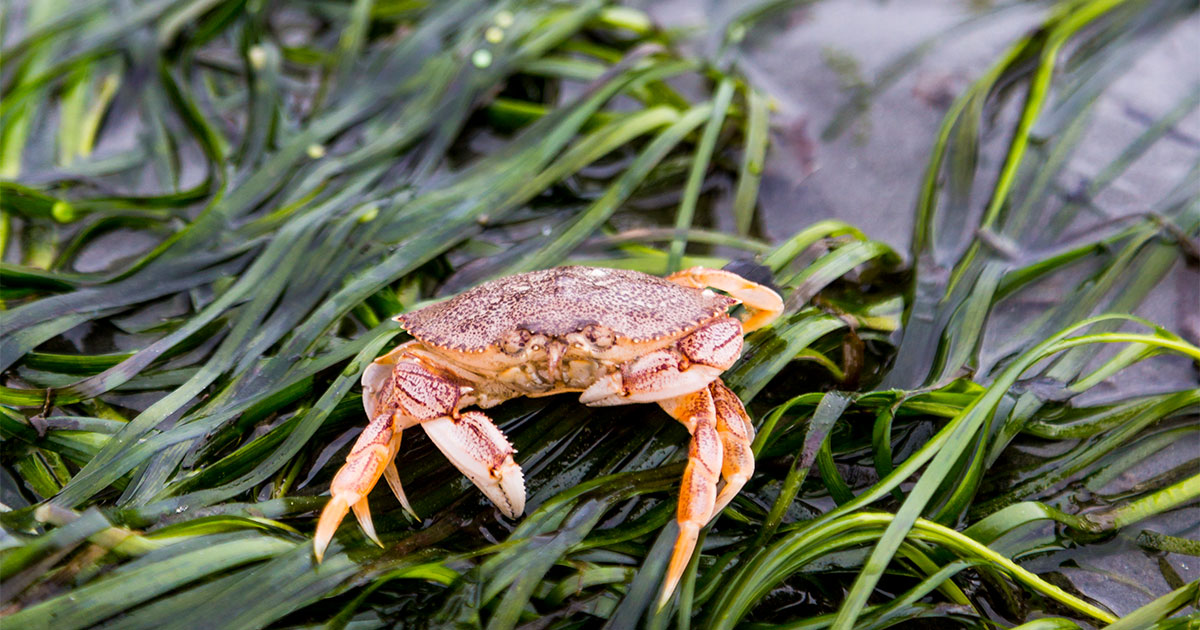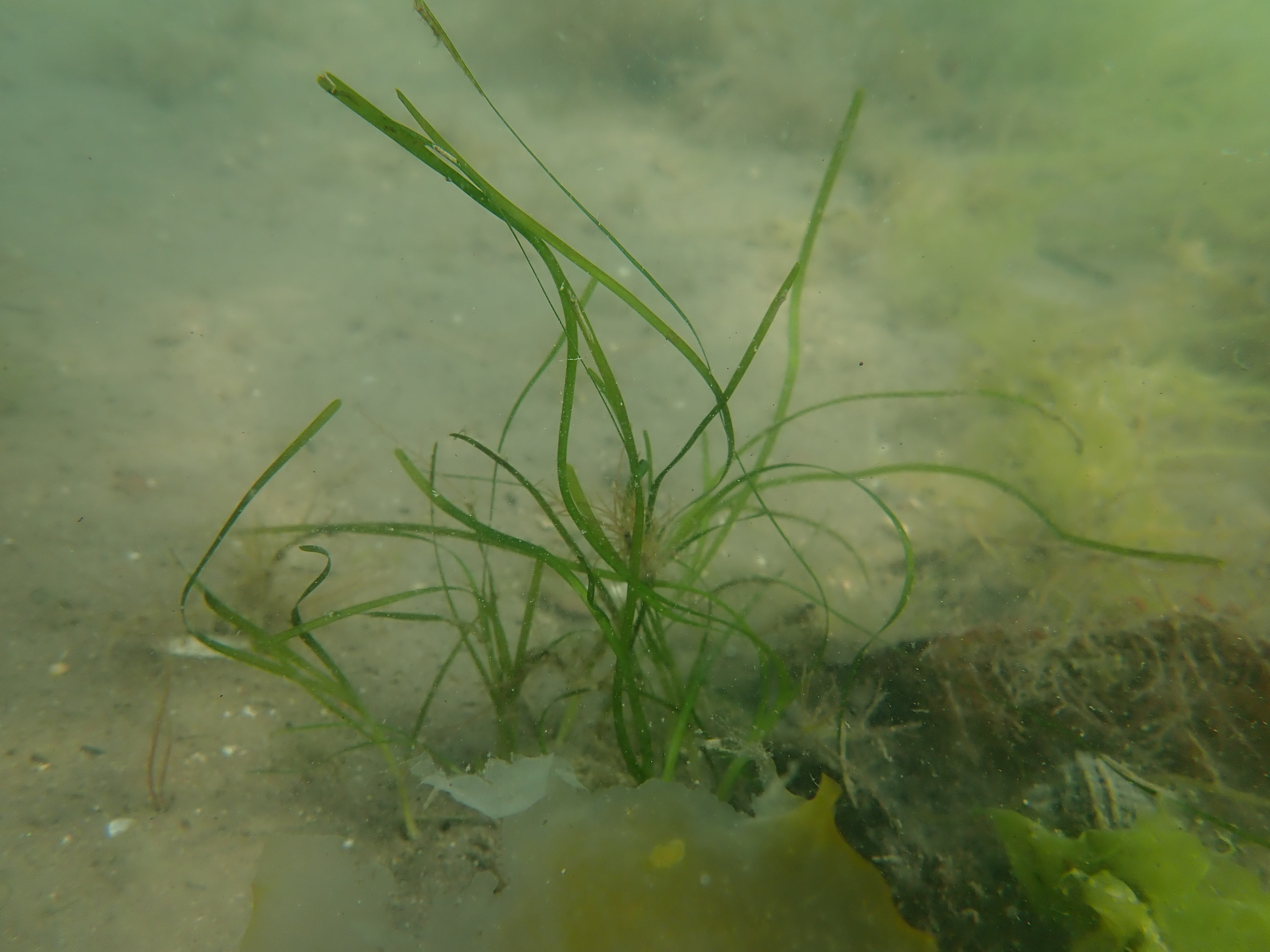As you walk the streets of Swansea, Wales, you will find “Ambition is Critical” inscribed into the pavement. These words are in response to a 1940’s description of the city by its most famous son, the poet Dylan Thomas, as “The Graveyard of Ambition”. In more recent times, Swansea is the antithesis of Dylan Thomas’ words. The city is the birthplace of a rapidly growing marine conservation charity, Project Seagrass. At the start of both the UN’s Decade of Ocean Science for Sustainable Development and the UN’s Decade of Ecosystem Restoration, Project Seagrass and our partners have set their ambitions truly sky-high with the aim to restore 30 square kilometers of seagrass habitat by 2030.
Just like Swansea itself, seagrass meadows are not the most beguiling of places. But these long-neglected uncharismatic marine ecosystems are slowly transforming from the ugly duckling into our beautiful Swan. Scientists, conservationists, governments, and even private enterprises are waking up to the vital role of these amazingly productive habitats. In particular, their key role in fighting the twin evils of the Climate Emergency and the Biodiversity Crisis. Estimates have indicated that seagrass, a habitat comprised of plants adapted to life in the ocean, may lock up carbon from our atmosphere at rates commonly higher than rainforests, support 20 percent of the world’s biggest fisheries, provide immense protection to our coastlines, and harbor enormous biodiversity.
Seagrass meadows in the UK provide a home to around 50 species of fish and they have particular importance as a nursery ground for juvenile cod, pollack, whiting and plaice, as well as herring and sea bass1. There are two species native to the UK; Zostera marina, which is primarily found below the low water line, and Z. noltii commonly found above low water. The state of the seagrass meadows affects the fishing quality of our waters and healthy meadows are highly effective at keeping our seas free of pollutants. Seahorses have also been recorded in UK seagrass, although recent observations are restricted to only a few sites. As a sensitive part of the coastal ocean, seagrasses need a sheltered environment. But locations ideal for seagrass are also where problems of pollution, coastal development and marine activity reach their maxima. Unfortunately, competition with humans takes its toll. As a result, the last few centuries have seen the decimation of the global coverage of seagrass.
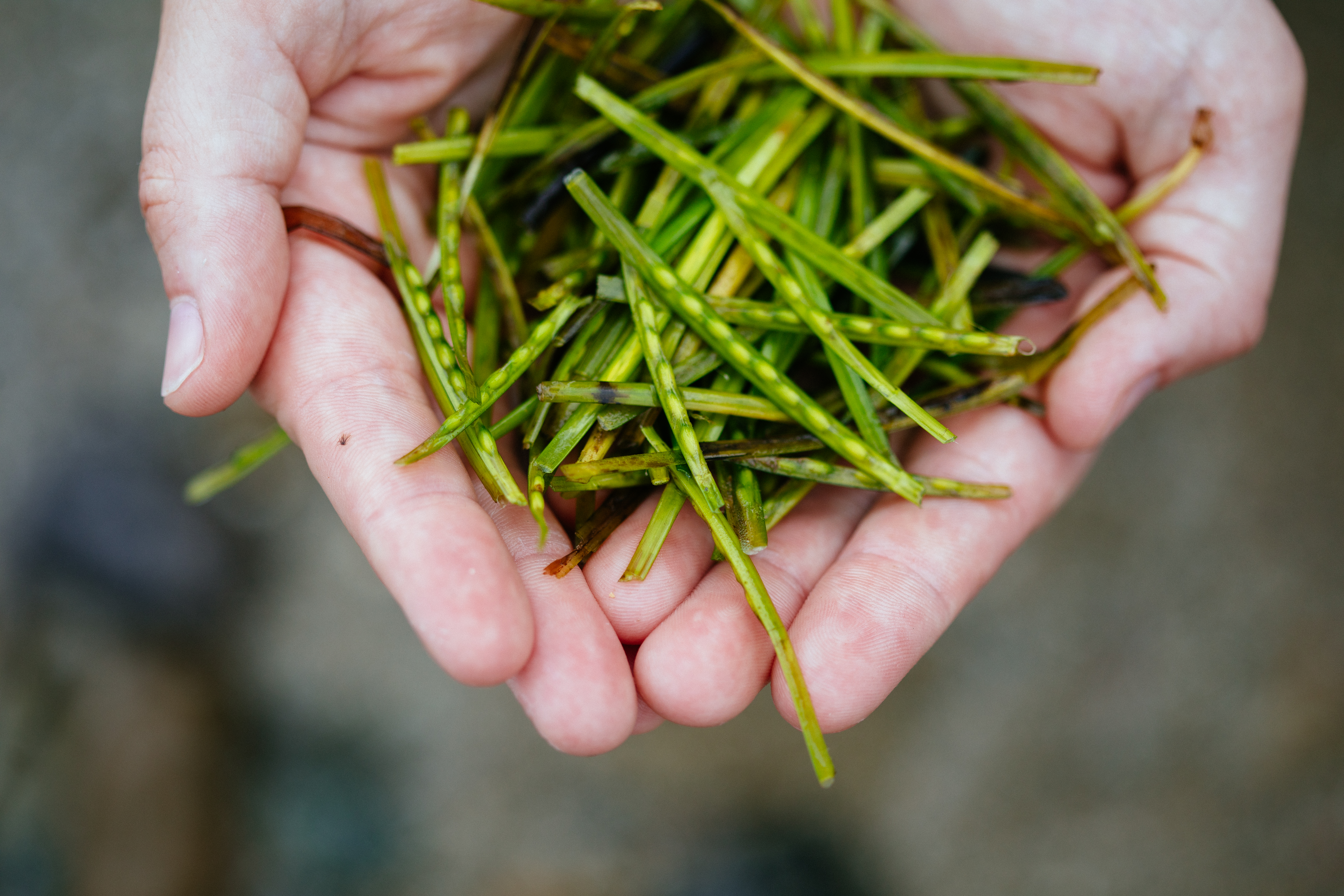
Seed pods (spathes) are collected by hand and processed in the laboratory where the seeds are separated and placed in small hessian bags together with sand. (Image credit: Nina Constable / WWF-UK)
In the UK, up to 92 percent of the seagrass has disappeared as a result of these interacting problems2. It is for these reasons that Project Seagrass and our growing consortium of partners are fighting back. With an ambitious timeline to bring life back to our UK seas, we hope to make these vital ecosystems productive once more so their biodiversity and productivity can support a healthy and resilient ocean, and provide food supply and vital coastal livelihoods.
In collaboration with Swansea University, Cardiff University, and other local partners, Project Seagrass have been researching ways to restore seagrass meadows around the UK coast. This grand endeavor has included field trials, working with local communities and conducting environmental modelling activities. The need to complete extensive underwater experimental studies, some involving complex diving work, often meant braving the challenging ocean conditions found along much of the UK’s coastline. Together, with the laboratory manipulation of environmental conditions and its impact upon seagrass3, these efforts are allowing the team to target restoration in the most appropriate localities.
After years of wrestling the waves, the team have now trialed a whole range of different methods for restoring seagrass, from transplanting existing plants from established meadows, to using support frames to help ensure plant survival4. But, in line with the world’s most successful seagrass restoration projects in Chesapeake bay5, the most success (as well as planting efficiency) has repeatedly come from planting seagrass seeds6. Albeit this comes with its own set of challenges.
The abundance of Green Crabs and high tidal currents in UK waters means that planting is done in a targeted and controlled manner. Seed pods (spathes) are collected by hand and processed in the laboratory where the seeds are separated and placed in small hessian bags together with sand. This seed-sand concoction is neatly secured to the seabed on long strings of biodegradable rope6, and the team heads back to shore with hopeful visions of flourishing seagrass meadows and marine life.
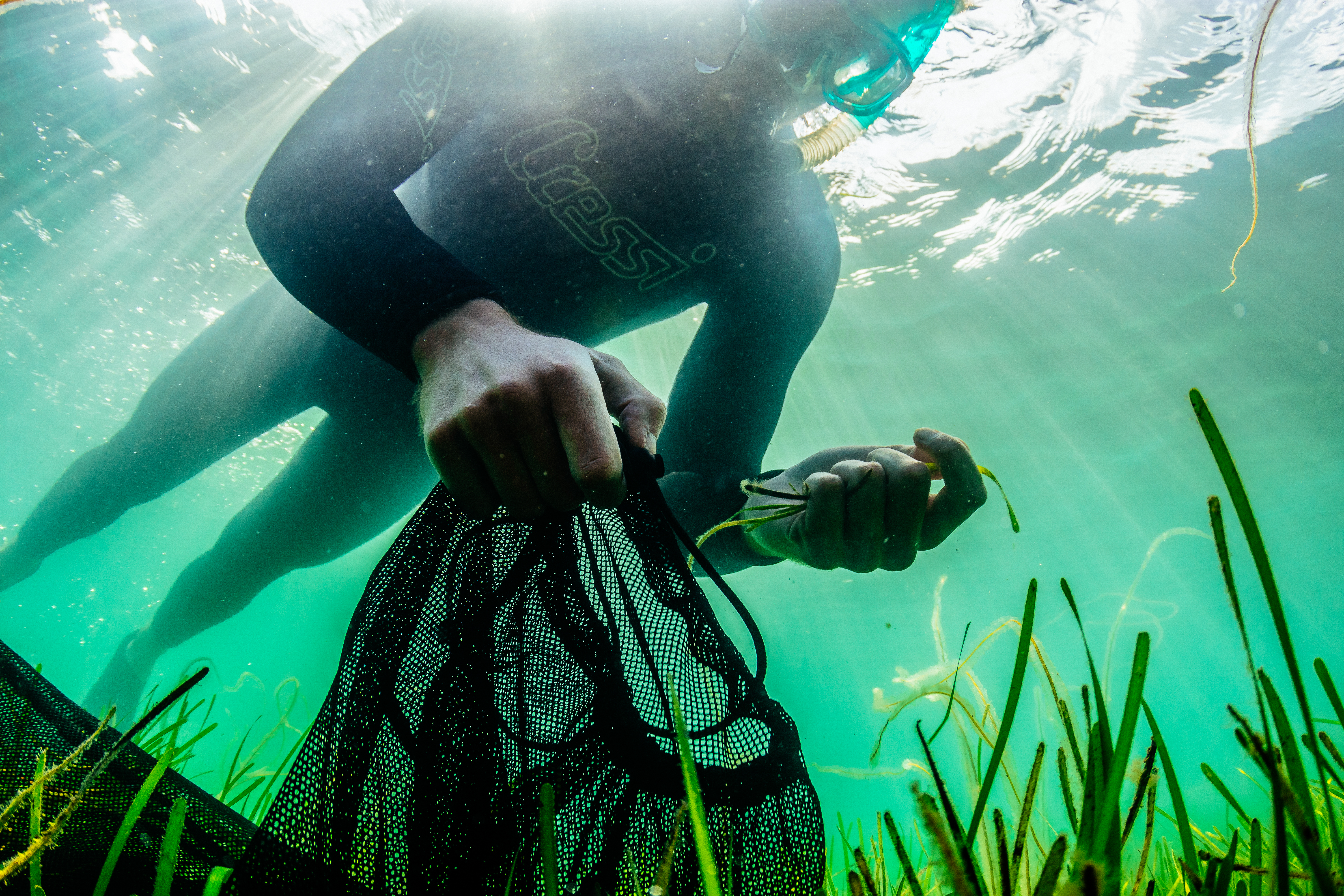
Volunteers braved difficult conditions along the Welsh coast to collect the precious seeds needed to restore two hectares of seagrass during a pilot restoration project. (Image credit: Lewis Jefferies / WWF-UK)
In partnership with Sky Ocean Rescue and the World Wildlife Fund (WWF), Project Seagrass and our university partners have taken the first step towards this big ambition by creating the UK’s first pilot restoration project. In Dale in West Wales, the team have planted over 1 million seeds of Zostera marina, with the aim of restoring two hectares of seagrass. But restoration is not just about successful planting. The team undertook a diverse range of work to reveal how marine habitat restoration can happen in partnership with the coastal communities that remain vulnerable to the changing use of the sea.
Seagrass Custodians
This has commenced with the launch of a Seagrass Community Group to advise on the future management of the restored seagrass. The successes of this group have included picking the planned footprint of the restoration area in consultation with local communities, streamlining the planting process to reduce local conflicts, and launching a fisheries award scheme to empower local fishers to become custodians of these incredibly important new marine resources.
Around 2,000 volunteers, including school children from around the UK, helped support this unique project, through the collection of seeds, through the preparation of the hessian bags with sand, and through the final filling of bags with seeds. In total, 20 kilometers of seed bag rope has now been carefully dropped into Dale Bay by a team on board a small boat. Over time, all of the natural materials used in the planting process will safely disintegrate, leaving the seagrass seedlings to take root and grow. To date, thousands of seagrass seedlings have started to germinate and develop, leading to the hope that it won’t be long before young fish are being protected by Dale’s emerging new seagrass meadow.
In Dale in West Wales, the team have planted over 1 million seeds of Zostera marina, with the aim of restoring two hectares of seagrass. (Image credit: Project Seagrass)
The work being done by Project Seagrass is inspiring a growing number of other restoration projects in the UK, a number of these in partnership with WWF, but also projects run by the Ocean Conservation Trust, the Wildlife Trusts and the Tees River Trust. It’s exciting times in the UK for seagrass restoration. There is even growing interest towards a notion of no net loss of biodiversity in the marine environment as a policy to mitigate the impacts of coastal and offshore infrastructure development. There is also increasing realization that carbon offsetting may create a means to further expand seagrass restoration to unprecedented scales.
Ocean Gardening
Today’s approach to seagrass restoration is largely akin to allotment gardening. Its dependent on the hard work of many people with low efficiency of effort. If Project Seagrass and our restoration consortium are to fulfil the aim of creating 30 square kilometers of seagrass, we need to find a more efficient approach.
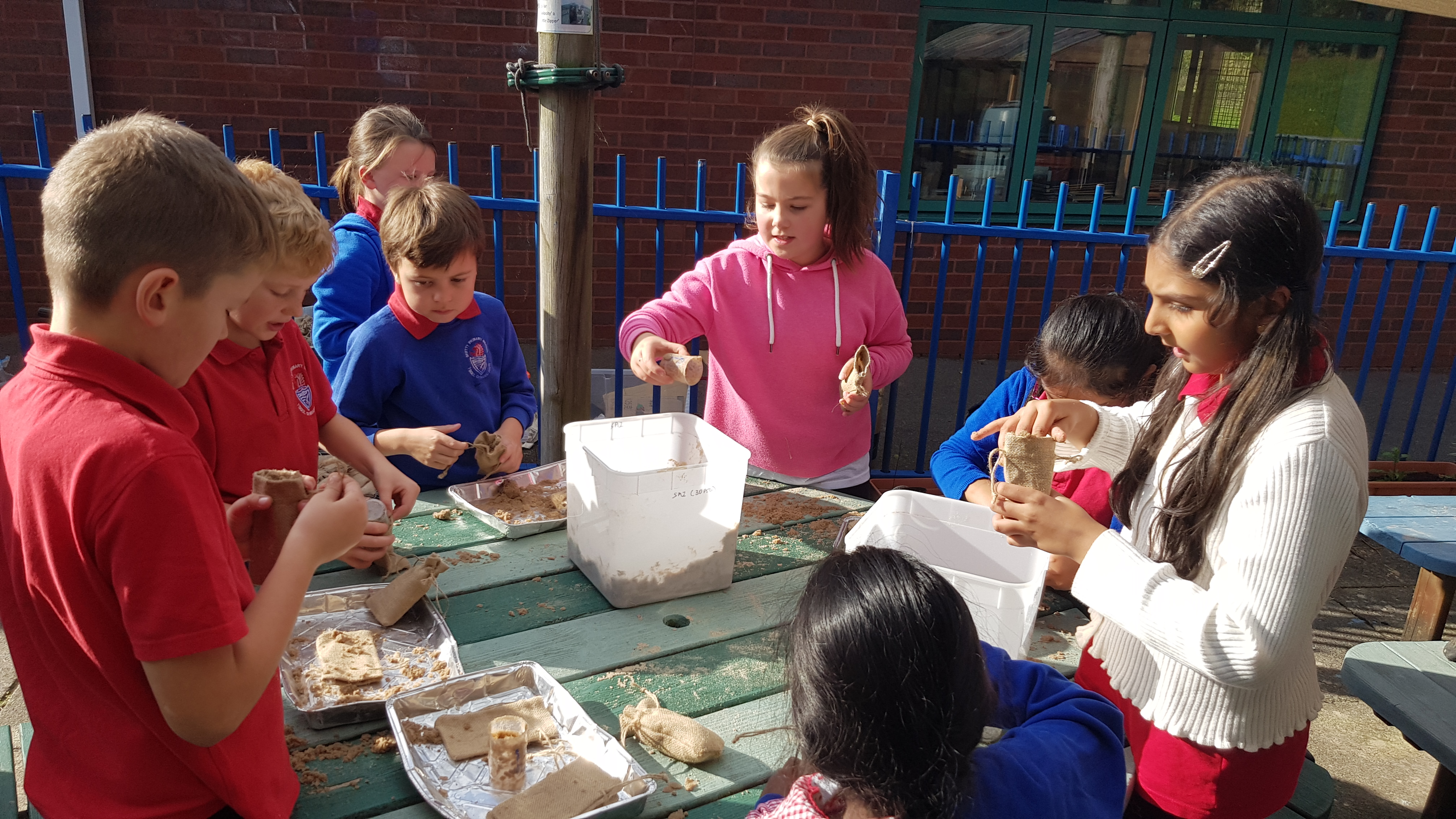
Around 2,000 volunteers, including school children from around the UK, helped support this unique project. (Image credit: Project Seagrass)
As partners to the UN’s Decade of Ecosystem Restoration, we are developing new ways to replace the inefficient allotment-type approach with a more mechanized industrial farming approach. By using novel interdisciplinary that links the best of biology, social science and engineering, we hope to become underwater farmers rather than underwater gardeners. Project Seagrass believe that only by taking this partnership approach can bottlenecks be overcome, ensuring seagrass can be planted at a scale that leads to vast improvements in the capacity of our coast to fight climate change and the biodiversity crisis, and ultimately achieve the goals of the Ocean Decade.
But ambition really is critical.
Want to learn more?
- Bertelli, C.M.; Unsworth, R.K.F. Protecting the hand that feeds us: Seagrass (Zostera marina) serves as commercial juvenile fish habitat. Mar. Poll. Bull. 2014, 83, 425-429, doi:10.1016/j.marpolbul.2013.08.011.
- Green, A.E.; Unsworth, R.K.F.; Chadwick, M.A.; Jones, P.J. Historical analysis exposes catastrophic seagrass loss for the United Kingdom. Frontiers in Plant Science 2021, doi: 10.3389/fpls.2021.629962, doi:doi: 10.3389/fpls.2021.629962.
- Bertelli, C.M.; Unsworth, R.K.F. Light Stress Responses by the Eelgrass, Zostera marina (L). Frontiers in Environmental Science 2018, 6, doi:10.3389/fenvs.2018.00039.
- Temmink, R.J.M.; Christianen, M.J.A.; Fivash, G.S.; Angelini, C.; Boström, C.; Didderen, K.; Engel, S.M.; Esteban, N.; Gaeckle, J.L.; Gagnon, K., et al. Mimicry of emergent traits amplifies coastal restoration success. Nature Communications 2020, 11, 3668, doi:10.1038/s41467-020-17438-4.
- Orth, R.J.; Lefcheck, J.S.; McGlathery, K.S.; Aoki, L.; Luckenbach, M.W.; Moore, K.A.; Oreska, M.P.J.; Snyder, R.; Wilcox, D.J.; Lusk, B. Restoration of seagrass habitat leads to rapid recovery of coastal ecosystem services. Science Advances 2020, 6, eabc6434, doi:10.1126/sciadv.abc6434.
- Unsworth, R.K.F.; Bertelli, C.M.; Cullen-Unsworth, L.C.; Esteban, N.; Jones, B.L.; Lilley, R.; Lowe, C.; Nuuttila, H.K.; Rees, S.C. Sowing the Seeds of Seagrass Recovery Using Hessian Bags. Frontiers in Ecology and Evolution 2019, 7, doi:10.3389/fevo.2019.00311.
This feature appeared in Environment, Coastal & Offshore (ECO) Magazine's 2021 Spring edition, to read more access the magazine here.


